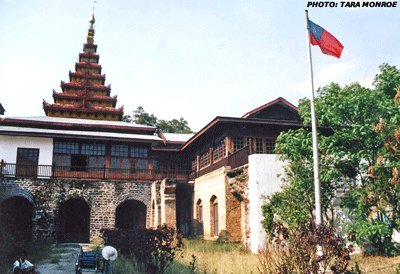Secrets of a Shan Palace
Does a protective curse prevent the regime from pulling it down?
Yawnghwe Haw, the large wood and brick palace of Burma’s first president, Sao Shwe Thaike, near Inle Lake in southern Shan State, has survived the ravages of Burma’s turbulent history—unlike its ill-fated former occupant, who died in jail.

Some suggest that the palace owes its survival to a protecting curse on anyone daring to pull it down. That was the fate of the famous Shan palace Haw Sao Pha Kengtung, demolished by the Burmese military junta in 1991.
Now known as Yawnghwe (Nyaungshwe)
Built in the
 |
|
“Elephant supported chair” dated 1864 and used by Nyaungshwe Sawbwas |
Visitors to the museum have access to three main wooden halls and the apartment of the Royal Mother. The Royal Throne Audience Hall houses the collection of thrones. The Inner Audience Hall displays primarily original costumes worn by the Mahadevi (Queen) and sawbwas of Yawnghwe, including some by Sao Maung, the sawbwa who preceded Sao Shwe Thaike. Most of these costumes date from the 1860s to 1890s. In the spacious Outer Audience Hall, visitors can view historic photos, statues, and an elaborate chair supported by carved elephants.
Laconic signs in English and Burmese explain the where, when and who of the artifacts in the collection; but the deeper history of these items and the people who used them is largely ignored, or perhaps intentionally excluded. Visitors are not told, for example, that the Inner Hall served as a place of worship for the family. Nor do visitors learn details of the daily lives and historical contributions of the palace’s residents.
Knowledgeable visitors can discover some of this deeper history by viewing the photograph collection housed in the apartment of the Royal Mother, and by recognizing the omissions in the photographic records. On display are images of Sao Shwe Thaike, his wife, parents and several relatives. The collection presents Thaike’s first wife, who died of tuberculosis, as the last Mahadevi of Yawnghwe.
1 | 2 next page »
